Top News
July 15, 2011 Ryukyu Shimpo
At a regular meeting on July 14, the Okinawa Prefectural Assembly (Chairman Zenshin Takamine) unanimously passed a resolution and statement of protest against and demand of withdrawal of plans to deploy the MV-22 Osprey vertical takeoff and landing transport aircraft to U.S. Marine Corps Air Station (USMCAS) Futenma. It is the first time that the assembly has adopted a resolution and statement of protest against the Osprey deployment.
On July 15, members of the Assembly will visit the Consulate General of the United States, the Okinawa Area Coordinator’s Office of U.S. Forces and other organizations to deliver the resolution and statement.
In the resolution of protest, the statement from the assembly touched on the fact that Osprey aircraft have crashed repeatedly both in the developmental stage and in service. They criticized the U.S. Forces stating that, “The level of noise pollution around the base will clearly increase if the Osprey is deployed. U.S. military officials insist that the Osprey is quieter and safer than the CH-46 (now in service at USMCAS Futenma), but it exceeds the CH-46 in maximum noise level at both take-off and landing.”
The assembly indicates that USMCAS will step up training drills for pilots when the Osprey is deployed. “Local residents and people at the elementary school next to the air station are concerned about noise pollution, environmental issues and the fear of possible crashes of aircraft,” an assembly member said.
With regard to the deployment plan, “This is a serious problem that impacts upon human life,” the assembly stated, but the assembly strongly criticized the stance of the central government, stating, “The government has only given a verbal report on it to the Okinawa Prefectural Government and the municipalities involved and it is not clear whether an assessment will be carried out. The government sees it only as a model change for the aircraft.”
In addition, the assembly called for a withdrawal of the Osprey deployment plan, stating that, “The fait accompli that the both governments try to unilaterally force upon residents runs contrary to the wishes of the people of Okinawa. The residents want to eliminate the risk as quickly as possible.”
The statement will be sent to Prime Minister, Foreign Minister and the Defense Minister of Japan. The resolution of protest will also be sent to U.S. Ambassador and U.S. military commanders in Japan.
(English Translation by T&CT, Mark Ealey)
Go To Japanese

Go To Video
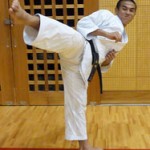
July 19, 2011 yoshiya Hokama of Ryukyu Shimpo
Yabu Junior High School in Nago City third year student 14 year-old Daigo Tamaki has been selected as a candidate for the Japan Junior & Cadet Karate Team. He will participate in the Cadet category (14‐15 years of age) of the Kumite competition in the 11th Asian Karate-do Championship to be held in Beijing, China from July 19.
According to Tsuguo Sakumoto, Chairman of the Technical Committee of the WKF (World Karate Federation), Tamaki is the first person from Okinawa to participate in the Cadet category of the Asian Karate-do Championships. He represented Okinawa in a trial held at the Japan Karatedo Hall in Tokyo from May 6 to 8.
His aggressive style put pressure on his opponents, winning him selection as a candidate member of the Japan Junior & Cadet Karate Team in the over 70-kilogram weight class.
Before the championship, Tamaki honed his skills with his peers and seniors in a training camp held from June 24 to 26 at Japan Karatedo Hall.
Tamaki started learning Karate nine years ago when he was in kindergarten, practicing an Okinawan style of karate known as Ryuei-ryu.
He talked about appeal of practicing karate, saying, “After practicing really hard, I really feel fulfilled when I win individual bouts or competitions.”
While Tamaki currently belongs to his junior high school karate club, he also practices Ryuei-ryu during the holidays, so is constantly focused on his karate practice.
With regard to the 11th Asian Karate-do Championship, he indicated his desire to win, saying, “I intend to do my best to win the championship. I hope to make the people to whom I owe so much, such as my teachers and seniors, really proud of my efforts.”
Tamaki talked about his dream, saying, “I would like to stay as a member of the national karate team and become a world class exponent of karate in future.”
Karate Chairman Sakumoto, who also coaches Tamaki Ryuei-ryu, says, “I am very glad that Tamaki has been selected as a candidate member of the national karate team. I hope that he does well in future. He is one of Japan’s up-and-coming exponents of karate. The younger generation of people doing karate will be inspired to greater efforts if Tamaki does well in competitions in Asia and the on the wider international stage.”
(English Translation by T&CT, Mark Ealey)
Go To Japanese
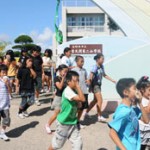
July 13, 2011 Ryukyu Shimpo
On July 12, an evacuation drill for a possible helicopter crash was carried out at the Second Futenma Elementary School, which is located next to the United States Marine Corps Air Station (USMCAS) Futenma. The children learned how to protect themselves from potential danger.
The school officials have been increasingly concerned about MV-22 Osprey vertical takeoff and landing aircraft, which will be deployed at Futenma next year, and the possibility of accidents.
The same type of evacuation drill has been held at this school since 2000, as preparation for the possible crash of aircraft from Futenma Air Station into the playground.
During the drill the children evacuated quickly from the classrooms to a nearby children’s center or square while covering their mouths with handkerchiefs, on the assumption that a toxic substance may be loaded onto a crashed aircraft.
A UH-1 helicopter hovered around the school both before and after the drill.
Nine year-old Koji Uehara said, “The helicopters used to fly very close to the school. I don’t feel safe, because sometimes the helicopters sound like something is wrong.” Ten year-old Ria Nakazato also shared her feelings after the drill, saying “I hope that if an accident occurs I can get away safely like we did in the drill today.”
“Okinawa is the only place in Japan where schools carry out such drills in preparation for an aircraft crash. This really is quite unreasonable,” said school principal Harumi Chinen indignantly. “The government has indicated that the Osprey will be deployed. The situation for us just gets worse and worse. We want to be rid of these dangers as soon as we can,” said the principal.
(English Translation by T&CT, Mark Ealey)
Go To Japanese
July 9, 2011 Ryukyu Shimpo
On July 1, the Okinawa Prefectural Government set up an information-gathering center in an attempt to better coordinate the information available for the recovery of remains of people who died in the Battle of Okinawa.
To make the task of recovering remains more effective, the project aims to share information on work that has previously been undertaken by volunteer groups, the prefecture and the various municipalities.
Based on the Ministry of Health, Labor and Welfare (MHLW) statement on July 7 that it intends to conduct a DNA analysis of teeth and finger bones that have been found, the prefectural government has indicated that it will request cooperation from the bereaved families within Okinawa and other prefectures for DNA data storage, and will continue discussions with MHLW.
The center will gather information about the remains of victims of the Battle of Okinawa, temporarily store those remains and provide some budgetary support for volunteer groups and individuals.
The center has commissioned the Okinawa Prefectural Peace Memorial Foundation to carry out these activities, and has set up an office within the Okinawa Prefectural Peace Memorial Park.
The project will cost 14 million yen in 2011, all of which will be provided by the Japanese government. Where necessary, the center will also offer financial assistance to projects such as locating unexploded ordnance.
According to the Welfare and Relief Division of the Okinawa Prefecture Department of Welfare and Health, in recent years, volunteer groups and individuals have conducted 75% of all such recovery work done in the prefecture.
Although the Japanese government has allocated an annual budget of six million yen to the prefecture to carry out this work, it has gone no further than providing information about the remains and destroyed shelters, and has not gone as far as collecting bones or remains.
The budget for the coming years is not yet settled, but a spokesperson for the Welfare and Relief Division said, “We would like to request budget for the next five years based on the achievements to date.”
Following the establishment of the center by the prefecture, Takamatsu Gushiken, the head of Gama Fuya (Cave-diggers), a volunteer group for the recovery and search of the remains of the victims of the Battle of Okinawa, said, “I hope that the center will be able to do something worthwhile for the war dead and their bereaved families.”
He also hopes that the Japanese government will carry out some form of DNA analysis.
(English Translation by T&CT, Mark Ealey)
Go To Japanese
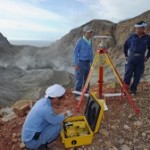
July 9, 2011 Sadaharu Shimabukuro of Ryukyu Shimpo,Photograph by Yasuhide Matayoshi of Ryukyu Shimpo
July 29 marks 52 years since the entire population of Iwo-Tori-shima (formerly Gushikawa Village, currently Kumejima Town) were forced to leave the island due to a volcanic eruption.
Kumejima Town carried out a survey of the island on July 6 and 7 in order to create a cadastral map.
No cadastral maps or registry books currently exist for the island so, the town carried out the survey to create those documents. This is the first field survey conducted by the town in two years.
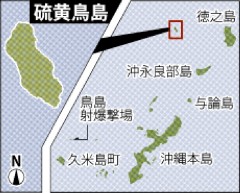
Iwo-Tori-shima (photograph taken by Yasuhide Matayoshi)
The Ministry of Defense (MOD) has announced that it is considering relocating the Tori-Shima range used by the U.S. military (Kumejima Town) to Iwo-Tori-shima.
A spokesperson for the town administration stated, “The survey had been scheduled before MOD’s announcement. It has nothing to do with the relocation issue.”
Mayor of Kumejima Town Choukou Taira clearly stated his opposition to the relocation, and there is growing opposition from the council and fishery cooperative of Amami-oshima island, which is close to Iwo-Tori-shima.
According to a spokesperson from Kumejima Town, by 2010 it came to own about 94% of the properties of the island with the remainder belonging to the Japanese government.
It is not clear exactly why there have been no registry books or cadastral maps created for the island, but it seems that this may be because of the disruptions caused by volcanic eruptions and wars.
The town conducted the survey by setting up airphoto signals, which are used when taking aerial photographs, in five locations on the island.
About Iwo-Tori-shima
A deserted island in the northernmost region of Okinawa, located 190 kilometers north-northeast of Naha and 65 kilometers west of Tokunoshima, Kagoshima Prefecture.
Comprising two conjoined volcanoes: Iwo-dake and Gusuku-dake, Iwo-Tori-shima is the only active volcano island in the prefecture of Okinawa. The island has seven kilometers of coastline with a total area of 2.5 square kilometers. It has been the source of sulfur since the time of the Ryukyu dynasty. People used to live on the island. Its northwest volcano erupted in June 1956, which caused the island’s entire population to leave.
The most recent eruption was confirmed as occurring in July 1968.
(English Translation by T&CT, Mark Ealey)
Go To Japanese
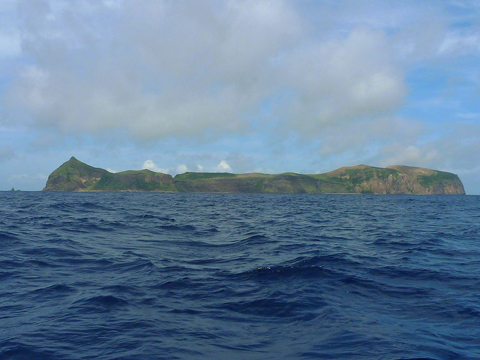
Slideshow of Iwo-Tori-shima

Go To Video
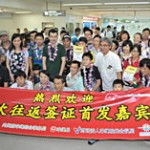
July 8, 2011 Ryukyu Shimpo
On the morning of July 7, ten people of the first tourist group on multiple-entry visas arrived at Naha Airport from Beijing via Haneda. Multiple-entry visas for Chinese tourists have been issued since July 1 allowing Chinese tourists to visit Japan anytime during its three-year period of validity. At the welcome ceremony held at the domestic terminal building of Naha Airport, Deputy Governor Yoshiyuki Uehara presented commemorative gifts of Ryukyu glass to each of the Chinese tourists.
On this day four flights from Shanghai and Beijing carried a total of 48 Chinese tourists to Okinawa on multiple-entry visas.
During their stay of one to three nights in Okinawa, they will visit the Churaumi Aquarium and Manzamo.
Deputy Governor Uehara said, “We hope that tourists from China will enjoy our natural environment, with its beautiful sea, and that they will be happy with the experience of Okinawan cuisine. We will make every effort to create an environment that they can enjoy and feel that they would like to come back to again in future.”
A woman tourist in the group said, “The multiple-entry visa does make it attractive to us. I really like the fantastic resorts in Okinawa, and would like to come again.”
(English Translation by T&CT, Mark Ealey)
Go To Japanese
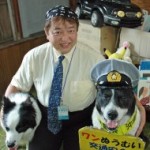
July 7, 2011 Ryukyu Shimpo
Bogey, a “canine police officer” well known to the residents of Urasoe City died of old age on July 5. In his role as a police public-relations dog he was a symbol of traffic safety activities through the years. Originally a stray dog, this canine hero was promoted to the honorary position of police officer. Yasunori Tedokon, the 47 year-old owner of Bogey has been working with him on activities to convey the importance of road safety. He said, “Bogey was a family member, a colleague, and a comrade who fought against traffic accidents. To show our feelings of gratitude, we want to have something like a funeral for him,” so a “farewell ceremony” will be held for Bogey on July 10.
Bogey was picked up on the road in 1996 and was looked after by Tedokon, his colleague drivers in the Urashiro Taxi Company, and others in the community.
Bogey took part in, and gained fame through, road safety campaigns with a signboard on his neck telling passersby, “I am Bogey. My only wish is for your traffic safety.” In 2003, he was appointed as a public-relations dog for Urasoe Police Station and was given resident registration by the Urasoe Municipal Office. He has been involved in traffic safety classes for nursery schools and children centers both inside and outside the city.
However, his health deteriorated from around 2009, and did he could not stand at all in his last week. On the morning of July 5, Tedokon gave him some water before starting work and Bogey drank it as though he enjoyed it, but died in his sleep at around 11:00pm that night.
Many letters and flowers of sympathy were sent to his owner from people both inside and outside of Okinawa who read the news of his death on the Internet. Tedokon said, “He was 90 years old in human terms; he has worked hard and I miss him deeply, but he will live on in the minds of children forever – as a canine police officer.”
(English Translation by T&CT, Mark Ealey)
Go To Japanese
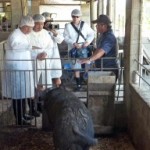
July 7, 2011 Ryukyu Shimpo
The crew of MediaCorp Channel 8, a state-run television channel in Singapore, visited Okinawa to make a television program about culture and food in various countries around the world.
From July 1 to 6, they collected material about the correlation between longevity and the Okinawan diet.
The crew also interviewed the staff at Omoro Farm, in Ada, Kunigami Village, where agu, or rare Okinawan native pigs, are raised.
Singaporean actor Darren Lim played the role of the presenter, covering topics such as how to raise agu, how to feed them and the difference in the taste between the male and female pigs.
On July 5, the crew tried some specialties made with agu at Sui Dunchi, a restaurant that cooks and serves foods made with agu from Omoro Farm.
Darren said, “Okinawa has a very good climate and is surrounded by beautiful sea. Its people are also very friendly. Okinawan cuisine has a variety of savory flavors and tastes, something like a mixture of Japanese and Chinese cuisine. I think that the rich and varied natural environment and the food, plus the slow lifestyle contributes to a high longevity in Okinawa.”
The group of reporters also visited the homes of elderly people in Ogimi Village and Nakijin Village who have passed the century mark, asking them about the secret of their longevity.
The television program is scheduled to be aired in Singapore this August.
(English Translation by T&CT, Mark Ealey)
Go To Japanese
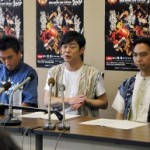
July 7, 2011 Ryukyu Shimpo
The Worldwide Eisa Festival 2011, which aims to establish a new style of “participatory Eisa” as a world standard, is scheduled to be held at Onoyama Stadium in Naha City on October 15 and 16.
While the festival has been held under the name “the National Eisa Festival” until last year, it has changed its name in association with the 5th Worldwide Uchinanchu Festival scheduled to be held at the same time in October.
The Worldwide Eisa Festival 2011 includes a “Creative Eisa Contest,” which invites various groups from within the prefecture, other prefectures and overseas to compete to impress and energize the audience and deliver something creative, “Traditional Eisa,” in which 18 groups of junior troupes from the prefecture are scheduled to participate, and “Chimdon (get excited) Stage,” in which the groups that want to exhibit Eisa and drum performance strive to entertain the audience.
At a press conference held on July 6, Daiichi Hirata, a member of the Festival Executive Committee and the head of the Department of Culture, Tourism and Sports in the Okinawa Prefectural Government, said, “While we respect traditional Eisa and think that creative Eisa does allow young people to more easily participate, we want to create a new style of Eisa, one that is even more participatory and interactive, a style through which people will be able to start new friendships.”
Singer songwriter Kazufumi Miyazawa, who composed and sings Shinkanucha (Fellowship), a song for the “Creative Eisa Contest,” said, “There are many people like myself living in other prefectures and other countries of the world who love Okinawa and are concerned about its future. I wrote this song in the wish that those people’s hearts would be united.”
For further details and for applications, call the Worldwide Eisa Festival 2011 Executive Office at 098 (867) 2622.
For the official website for the festival, access http://www.eisa-okinawa.com/
(English Translation by T&CT, Mark Ealey)
Go To Japanese
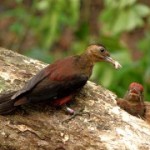
July 6, 2011, Ryukyu Shimpo
Two Okinawa woodpecker chicks safely left their nest in an itaji tree (biological name: Castanopsis sieboldii) blown over by the strong winds of Typhoons No.2 and No.5 in Nishime-dake, Kunigami Village.
This situation was confirmed by 48 year-old Yutaka Toguchi, who has been commissioned by the Ministry of the Environment (MOE) to conduct a survey on Okinawan woodpeckers.
A representative of the Yambaru Wildlife Conservation Center of the MOE said that, “The chicks successfully left a nest in a fallen tree, something that we have never seen before.”
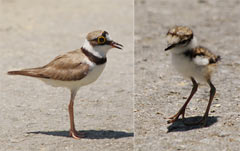
Little ringed plover (on left) and the chick in Yagaji Island, Nago City on July 3 (photograph provided by Yutaka Toguchi).
On July 3, Toguchi also observed two young little ringed plovers (biological name: Charadrius dubius) and another two parent birds on Yagaji Island, which is designated as a wildlife reserve. Yagaji Island is the fourth location in Okinawa where little ringed plovers are known to breed, and this is the first time to confirm this occurring in the northern part of the prefecture.
Toguchi happily said, “I have been observing birds for thirty years, but I now feel like my dream has come true.”
Toguchi found an egg of an Okinawan woodpecker in a nest build in a dead itaji tree.
The strong winds of Typhoon No.2 broke its trunk and the tree started leaning on the one next to it.
The parent bird continued to protect the eggs and two chicks were confirmed as being alive.
The winds of typhoon No.5 completely blew the tree over, but the parent bird continued feeding its young, which then left the nest on June 29 and July 2.
When a tree in which a nest is built falls to a ground, it is highly likely that any chicks inside could be preyed upon by their natural enemies or could drown in rainwater that might pour into the nest.
Toguchi said happily, “It’s a miracle for chicks to safely be able to leave the nest in this kind of situation. Those typhoons caused severe damage throughout the whole prefecture, but the Okinawan woodpeckers are still going strong.”
Little ringed plovers usually breed in locations north of Kyushu and then migrate to Okinawa for the winter. It is very rare for them to breed in Okinawa.
While little ringed plovers normally breed on dry riverbeds, these birds were confirmed to be breeding near sediment dredged up in a fishing port in Yagaji Island. It seems that two or three days had passed since the chicks hatched.
Toguchi said, “The chicks are finding their feet now, but they will become able to fly within about 20 days. I will continue to keep an eye on them.”
(English Translation by T&CT, Mark Ealey)
Go To Japanese
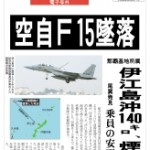
July 5, 2011 compiled from reports of Ryukyu Shimpo
According to the Naha base of the Japan Air Self-Defense Force (JASDF) and the 11th Regional Coast Guard Headquarters, at 10:29am on July 5, an F-15 fighter aircraft based in Naha went missing at a point north of Kume-jima, about 180 kilometers northwest of Naha.
Smoke and oil were found on the surface of the sea about 140 kilometers northwest of the lighthouse on Ie-jima. At 11:26am that same day, a JASDF search plane found what may be the tail of the missing F-15. The whereabouts of the pilot of the single-seat jet fighter are still unknown and a JASDF rescue team is continuing its search.
According to the 11th Regional Coast Guard Headquarters, the Maritime Self-Defense Force stated that on around 10:47am that same day, “We received a distress signal from the fighter and the crew of a rescue aircraft confirmed the presence of oil and smoke on the sea at the possible scene of the accident. A spokesperson for the Naha base said, “The missing JASDF aircraft took off from Naha Airport on a training mission at 9:59am that day.”
Go To Extra edition(PDF)
Go To Japanese
Naha City Mayor makes request regarding the F-15 crash.
July 7, 2011 compiled from reports of Ryukyu Shimpo.
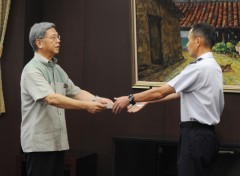
Takeshi Onaga (left), the Mayor of Naha City, suggests a safety inspection of F-15s to the base commander of the JASDF Naha, Masashi Yamada, on July 7.
With regard to the F-15 fighter crash, in the afternoon of July 7, Takeshi Onaga visited the Naha base of the Japan Air Self‐Defense Force (JASDF) within Naha Airport to meet the base commander, Masashi Yamada. Onaga stated, “If the crash had occurred in the vicinity of Naha Airport it could have involved commercial aircraft and caused a major disaster. I request that safety inspections of all aircraft belonging to JASDF be conducted immediately. We also strongly request that you take preventive measures to avoid accidents and to publish the results of the investigation into the F-15 crash.”
Go To Japanese
(English Translation by T&CT, Mark Ealey)















 Webcam(Kokusai Street)
Webcam(Kokusai Street)


